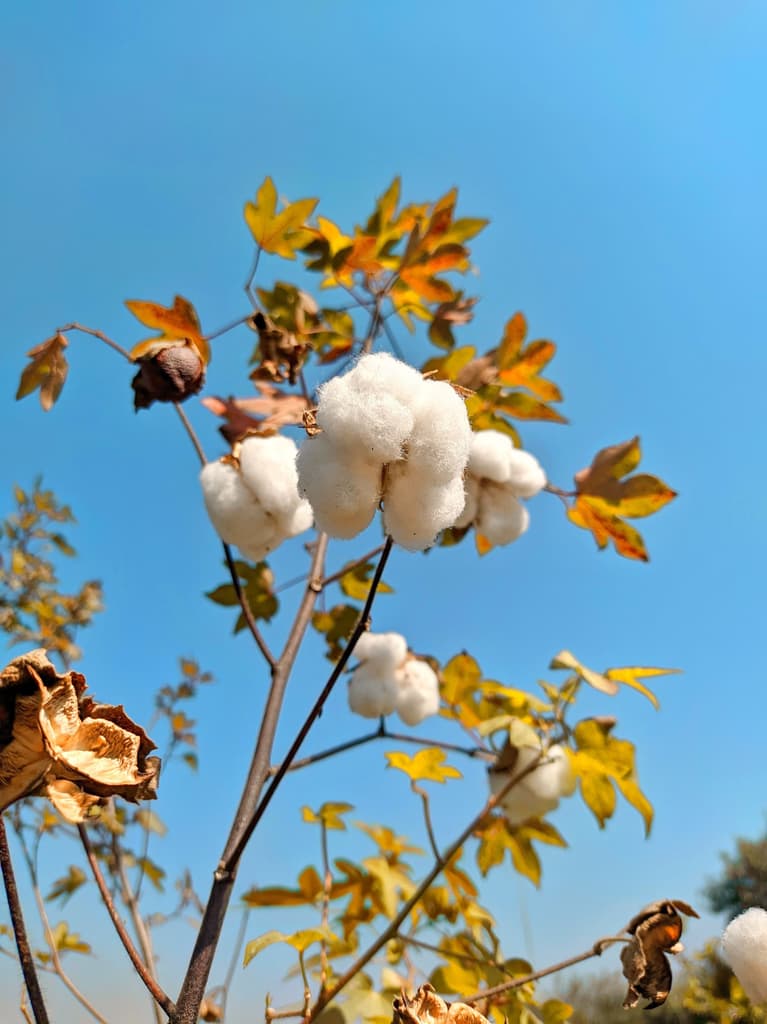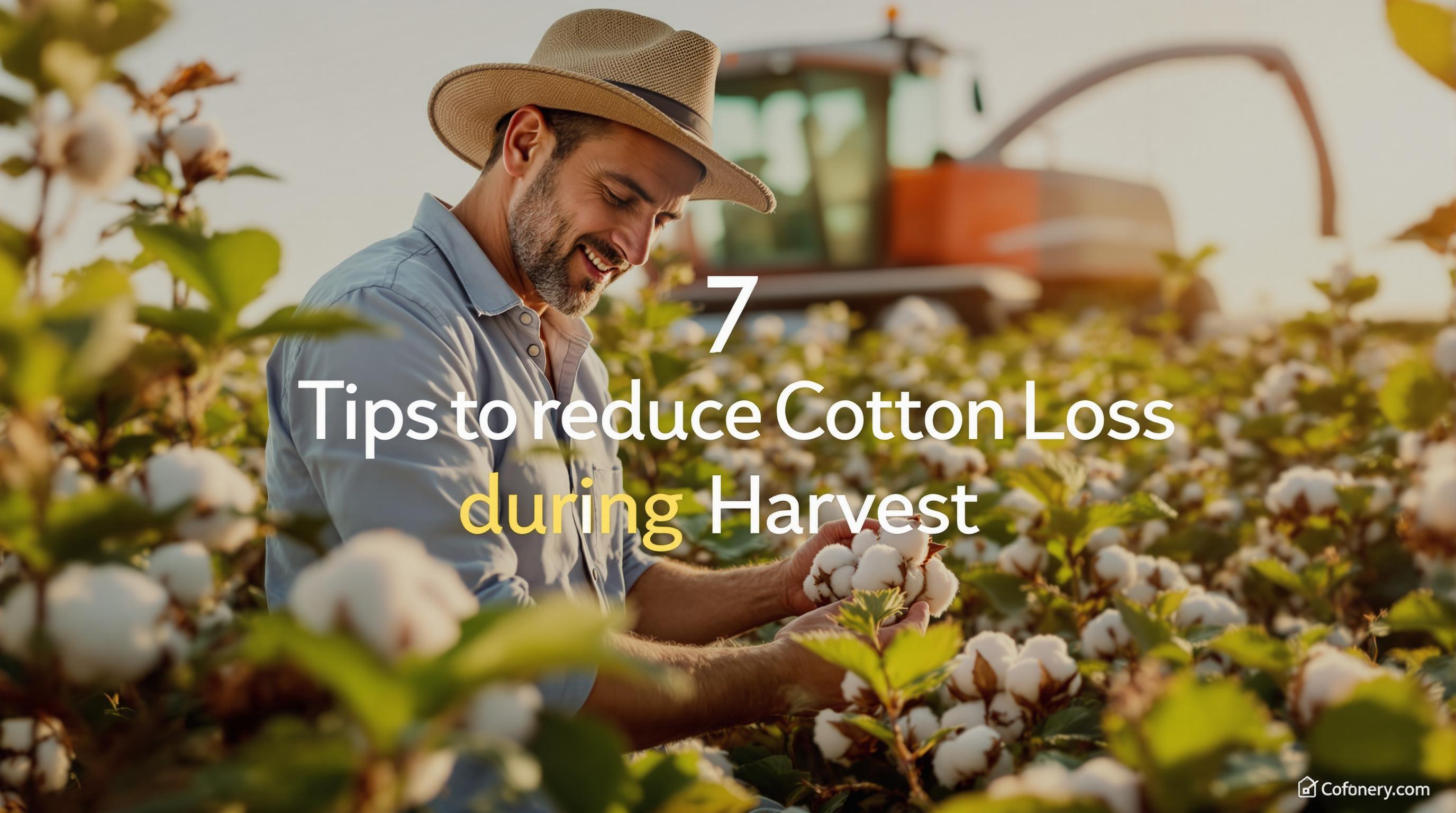CottonConnect works to improve cotton farming by addressing environmental and market challenges. They focus on helping farmers reduce resource use, improve soil health, and increase profitability through training and new farming techniques. Their programs also prioritize transparency, allowing consumers and brands to trace cotton from field to product. Key initiatives include:
- REEL Cotton: Focuses on soil health, water management, and reducing chemical use.
- Women in Cotton: Supports female farmers with leadership training and financial literacy.
- Technology Tools: Tracks farming practices with apps and impact calculators.
These efforts aim to meet consumer demand for responsibly sourced cotton while helping U.S. farmers access premium markets and improve their livelihoods.
The future of cotton farming: scaling regenerative sourcing
Key Programs by CottonConnect
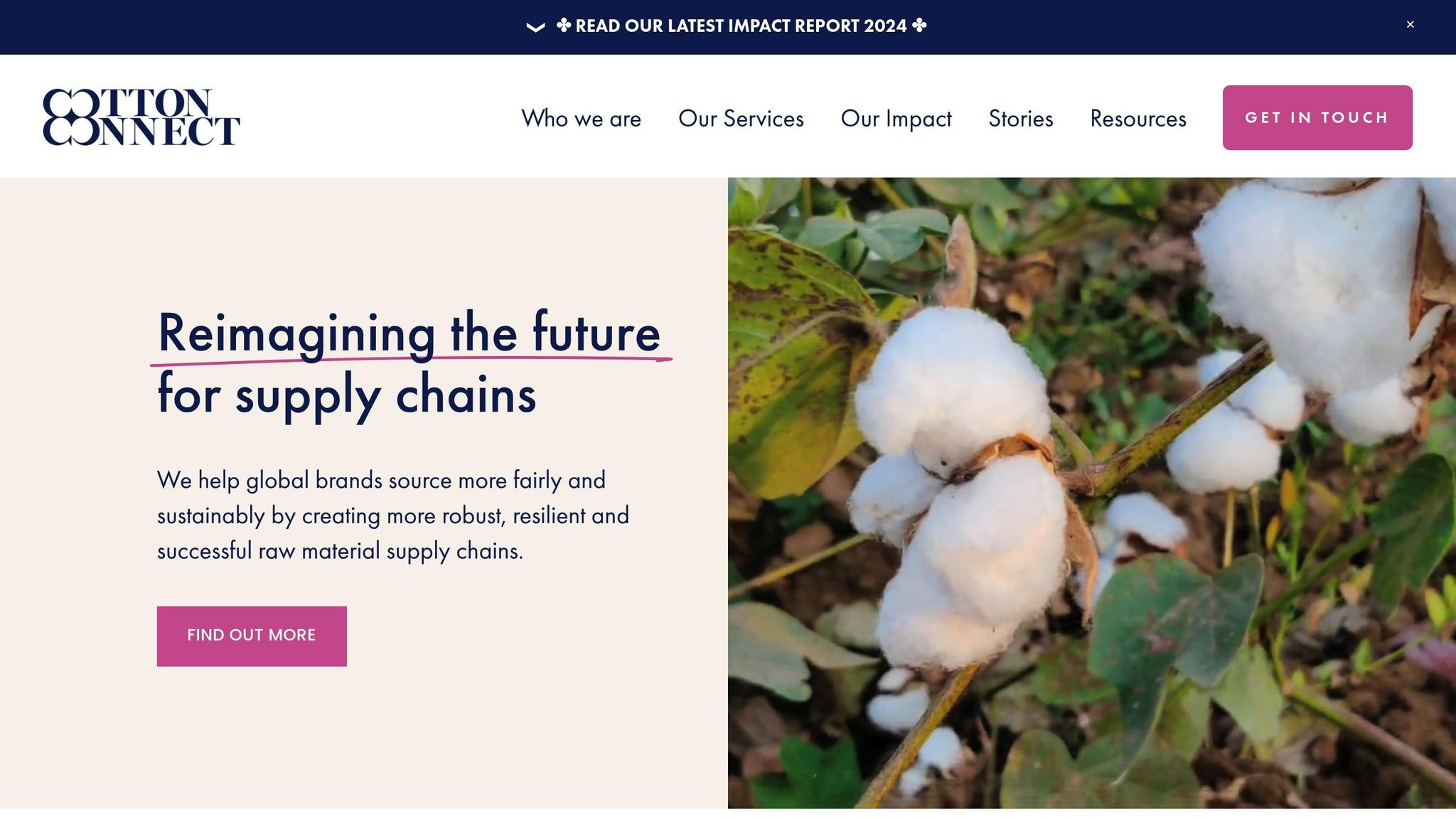
CottonConnect runs several programs aimed at promoting sustainable cotton farming. These initiatives address environmental and social challenges while supporting farming communities and supply chains. Here's a closer look at some of their key efforts.
REEL Cotton and Regenerative Farming Practices
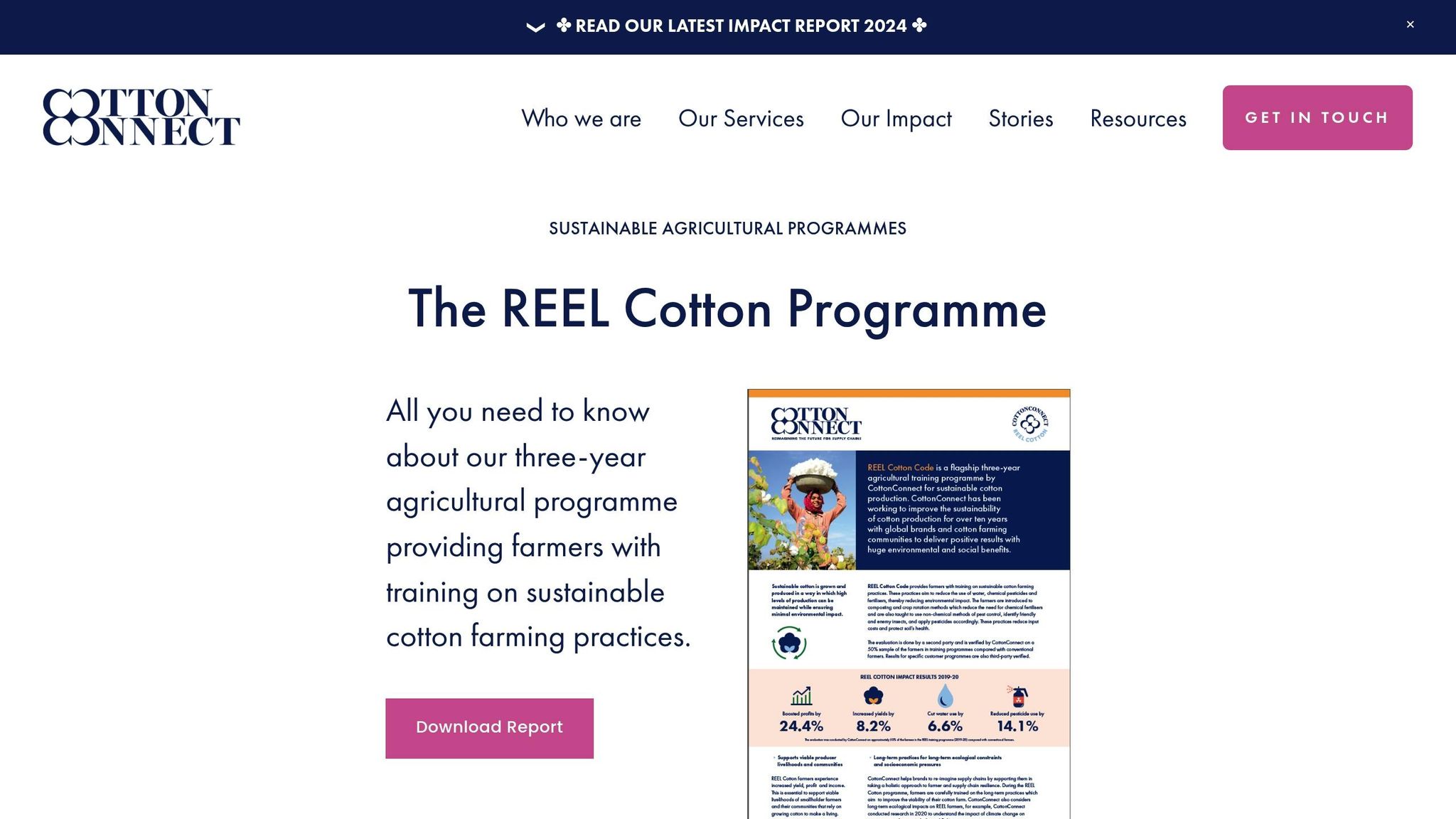
CottonConnect’s REEL Cotton program focuses on restoring natural resources while improving farming practices. The initiative emphasizes soil health through techniques like cover cropping and crop rotation, which help prevent erosion, boost soil fertility, and reduce the need for chemical inputs. Farmers also adopt integrated pest management, using natural predators to minimize pesticide use and lower costs.
Water management plays a big role in the program. Farmers are trained in precision irrigation methods that make water use more efficient, ensuring sustainability in areas where water is scarce. These regenerative farming practices not only benefit the environment but also set the foundation for broader community development.
Women in Cotton and Social Empowerment
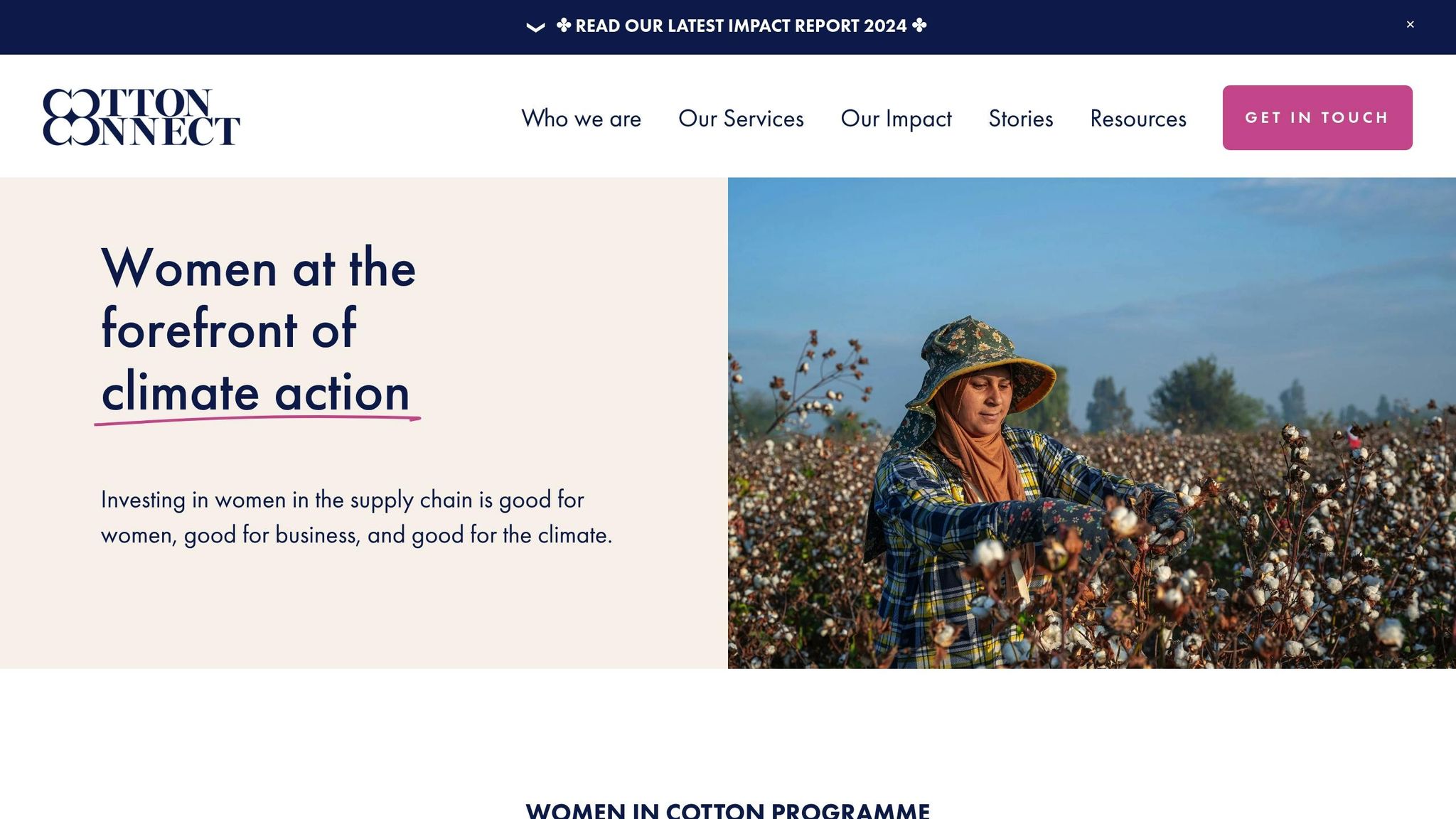
The Women in Cotton program is designed to support female farmers by offering leadership training, financial literacy education, and opportunities to form cooperatives. These cooperatives enable women to share resources and negotiate better deals collectively. The program also addresses workplace safety by providing training on proper equipment use and educating participants about labor rights, ensuring safer and fairer working conditions.
Tracking Results and Setting Goals
CottonConnect uses a robust digital monitoring system to measure the impact of its programs. The system tracks environmental improvements like reduced water use, lower chemical inputs, and decreased emissions. It also monitors social indicators, such as increased incomes, greater participation of women, and better access to education and healthcare. On the economic side, the data highlights improvements in crop yields and cost savings.
Farmers participating in these programs often report higher earnings due to better resource management and access to premium markets. This data not only validates the success of initiatives like REEL Cotton and Women in Cotton but also helps identify areas where further improvements are needed.
To streamline data collection, CottonConnect uses mobile technology. Farmers can report their practices and results through smartphone apps, creating a real-time database. This approach helps pinpoint effective strategies and ensures continuous progress in sustainable cotton farming.
Tools and Methods for Better Cotton Practices
CottonConnect is making strides in improving cotton farming by combining technology, education, and business support.
Technology Tools for Tracking Progress
CottonConnect uses a range of digital tools to monitor and verify sustainable farming practices. These include impact calculators, supply chain tracking systems, and mobile apps. For example, environmental impact calculators help farmers measure key metrics like carbon emissions, water usage, and biodiversity effects. Supply chain tracking systems, on the other hand, ensure transparency, tracing cotton from the fields all the way to the finished product. Together, these tools provide actionable insights that guide more effective training and resource allocation.
Training and Practical Resources
To empower farmers, CottonConnect offers tailored training modules focused on areas like soil health, water conservation, organic certification, and pest management. These resources come in various formats, such as video tutorials, printed guides, and hands-on workshops. The goal? To help farmers boost soil fertility, use water more efficiently, and adopt precise pest management techniques - reducing the need for broad-spectrum pesticides in the process.
Support for U.S. Cotton Businesses
CottonConnect also extends its efforts to support U.S. cotton enterprises by offering tools and consultation services designed to verify and promote sustainable practices. These tools allow businesses to document their environmental impact and track sustainable cotton throughout the production process. Additionally, businesses gain access to market intelligence tools that highlight sustainability trends and buyer preferences. Resources like cottongins.org play a crucial role by providing a detailed directory of cotton gin facilities across the U.S., helping connect sustainable farming initiatives with processing centers in various regions.
sbb-itb-0e617ca
Business Benefits of Better Cotton Practices
CottonConnect’s dedication to sustainable cotton practices demonstrates how these efforts can bring tangible business benefits. Companies adopting these methods not only gain a competitive edge but also strengthen ties with consumers and key stakeholders.
Value Creation for Brands and Retailers
Embracing better cotton practices offers a range of advantages for brands and retailers. Businesses that integrate sustainable cotton into their operations often find themselves better equipped to secure premium pricing and navigate potential risks within their supply chains.
By addressing environmental, labor, and regulatory challenges, sustainable practices help reduce vulnerabilities in the supply chain. CottonConnect’s network connects brands with suppliers who adhere to established environmental and social standards, ensuring both quality and compliance.
Traceable supply chains play a critical role in building consumer trust. When companies can back their claims with clear, documented evidence, they not only enhance their credibility but also streamline compliance processes, saving time and resources.
A commitment to sustainable cotton doesn’t just boost operational efficiency - it also elevates brand reputation, attracts favorable financing opportunities, and fosters customer loyalty. These benefits lay the groundwork for successfully marketing sustainable cotton products to U.S. consumers.
Marketing Better Cotton to U.S. Consumers
American consumers are increasingly drawn to products with verifiable sustainability claims. Successfully marketing better cotton products involves highlighting both their environmental and social benefits, ideally supported by third-party certifications.
CottonConnect’s traceability tools enable brands to share specific impact data, creating compelling stories about the positive effects of their practices. This transparent, data-driven approach resonates with U.S. consumers who value detailed product information.
Certification labels and recognized sustainability credentials can help products stand out in retail environments. Better cotton items might earn premium shelf placement or be featured in retailer sustainability initiatives, increasing visibility and appeal.
Additionally, adopting sustainable cotton practices can open doors to new partnerships. As retailers increasingly prioritize environmental responsibility in their sourcing, brands committed to sustainability gain access to fresh opportunities for growth and collaboration.
Comparison Table: Benefits and Challenges of Better Cotton
| Aspect | Benefits | Challenges |
|---|---|---|
| Environmental Impact | Reduced water usage, lower pesticide use, improved soil health, smaller carbon footprint | Learning curve, weather dependency, transition requirements |
| Economic Returns | Potential for premium pricing, lower input costs | Higher upfront investments, certification expenses, market fluctuations |
| Supply Chain | Enhanced traceability, stronger supplier relationships, reduced compliance risks | Complex verification processes, increased documentation, coordination challenges |
| Market Position | Differentiation in the market, increased consumer trust, stronger ESG appeal | Competitive pressure, complex marketing strategies, need for consumer education |
| Operational Efficiency | Streamlined compliance, better quality control, stronger stakeholder relationships | Training requirements, system integration, ongoing performance monitoring |
Transitioning to better cotton practices requires thoughtful planning and upfront investment, but businesses often find the long-term benefits far outweigh the initial hurdles. CottonConnect offers frameworks to help companies manage these transitions more smoothly while maximizing the potential returns.
The key to success lies in consistent execution and regular evaluation. Companies that embed sustainability into their core operations - rather than treating it as an optional add-on - are more likely to achieve meaningful, lasting results. This aligns closely with CottonConnect’s mission to drive systemic change in the industry.
Connecting CottonConnect's Work with U.S. Cotton Infrastructure
Bridging sustainable cotton initiatives with the well-established U.S. cotton infrastructure is essential for advancing environmentally conscious practices. Cotton gins play a pivotal role in this process, acting as key partners in sustainable cotton production.
Opportunities for U.S. Cotton Gins
When U.S. cotton gins engage in sustainability programs, they contribute to greater transparency across the supply chain and embrace better practices. This involvement strengthens regional networks, making it easier to share methods for sustainable production while ensuring supply chain reliability. A centralized platform can further streamline these efforts, creating more opportunities for collaboration and progress.
The Role of Directories like cottongins.org
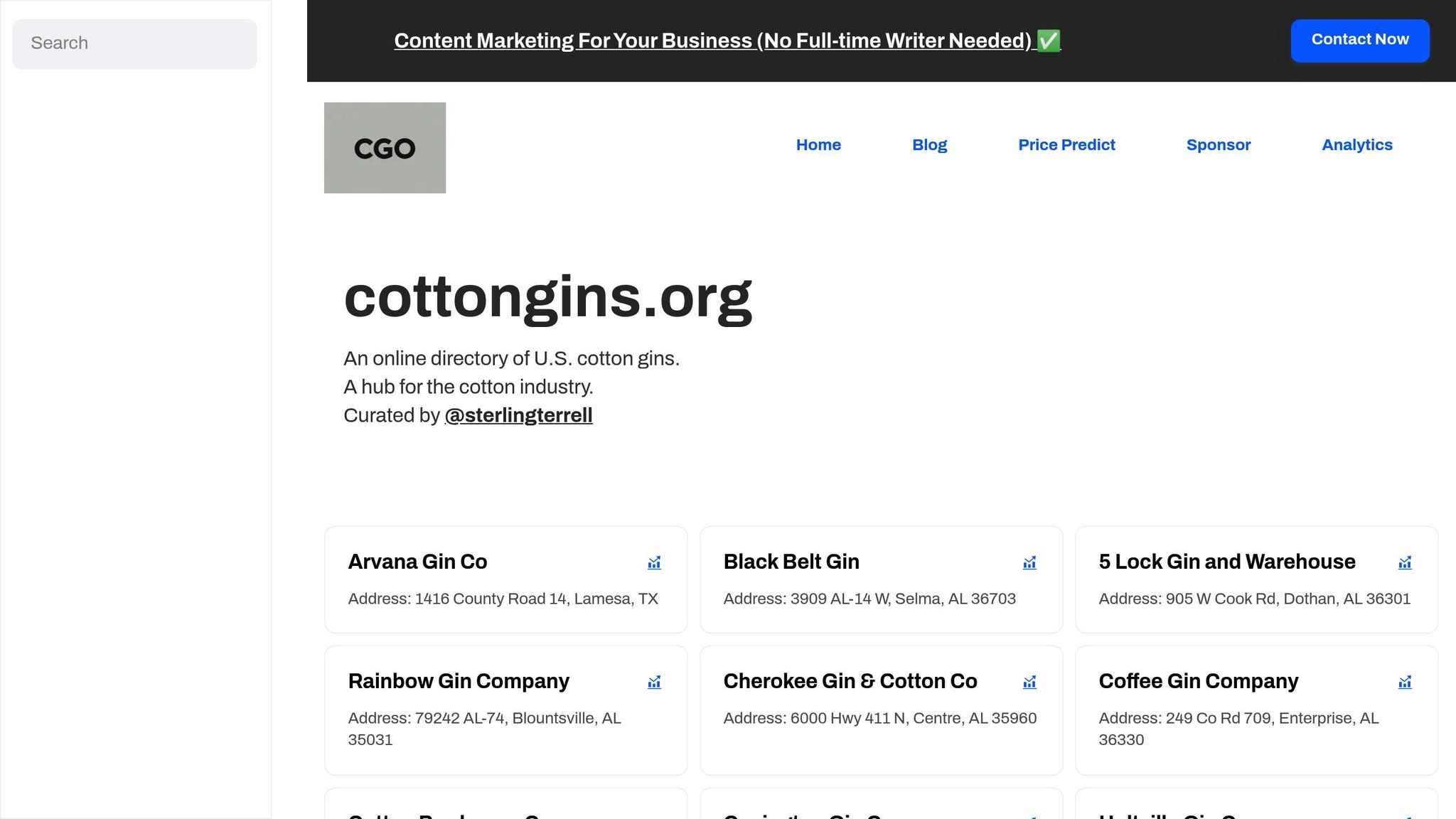
Platforms like cottongins.org play an important role in connecting cotton gins with sustainability-focused initiatives. By providing a centralized directory of gin locations, these platforms enhance visibility and open doors for gins to collaborate with organizations dedicated to sustainable practices. Being listed on such platforms raises the profile of these facilities within the sustainability ecosystem.
Building Partnerships in the U.S. Market
Effective sustainable cotton programs thrive on collaboration across the supply chain. Trusted directories like cottongins.org, along with direct engagement efforts, help CottonConnect establish regional partnerships tailored to local growing conditions and existing business relationships. These partnerships foster the exchange of knowledge and resources, driving progress toward more sustainable cotton production practices.
Conclusion and Future Outlook
CottonConnect's targeted approach shows that sustainable practices have the power to reshape the cotton industry. Programs like REEL Cotton and Women in Cotton have expanded the concept of sustainability, demonstrating it's about more than just environmental benefits.
By building on these successful initiatives, CottonConnect has established clear, measurable standards for sustainable cotton. The integration of technology to track impacts highlights that sustainability isn't just good for the planet - it's also a smart business move. When brands and retailers adopt these practices, they tap into new opportunities that align with the values of U.S. consumers, who are increasingly prioritizing environmental responsibility.
Cotton gins, as critical players in the supply chain, are uniquely positioned to champion sustainability efforts. With existing infrastructure and support from networks like cottongins.org, they have the tools to drive collaborative progress. These efforts not only strengthen the industry today but also pave the way for future advancements.
Programs like REEL Cotton and Women in Cotton also underscore the importance of partnerships and shared knowledge. As regional networks grow and evolve, the industry gains from greater supply chain transparency and reliability. Cotton gins that take an active role in these sustainability initiatives can establish themselves as leaders in a market that's rapidly changing.
The future of sustainable cotton is clear. With proven programs, a strong U.S. cotton infrastructure, and growing consumer demand for responsible practices, the path forward is set. The foundation is in place - now it's up to U.S. cotton businesses to seize the moment and drive meaningful progress in sustainable cotton practices.
FAQs
How does CottonConnect promote transparency and traceability in the cotton supply chain?
CottonConnect is making strides in improving visibility and accountability within the cotton supply chain through its traceability software. This platform tracks transactions starting right at the farm level, ensuring that the cotton being produced matches the procurement activities carried out by ginners.
On top of that, CottonConnect works closely with suppliers by organizing workshops and hosting stakeholder meetings. These initiatives help strengthen partnerships and make it possible for brands to trace their cotton all the way back to its source. By promoting an open and accountable supply chain, CottonConnect supports businesses in achieving their traceability objectives while encouraging more responsible practices.
What advantages do U.S. cotton farmers gain by joining CottonConnect's sustainable programs?
U.S. cotton farmers participating in CottonConnect's programs gain several practical benefits. These programs are designed to cut farming input costs, promote healthier soil, and introduce regenerative agriculture practices that prioritize long-term environmental care.
Joining these initiatives also helps farmers better navigate climate challenges and market shifts, creating a steadier, more reliable path forward for their farming operations.
How does the Women in Cotton program support female farmers and benefit their communities?
The Women in Cotton program is making a real difference for female farmers by offering training in organic and sustainable farming practices. Beyond teaching essential skills, this initiative helps women boost their confidence, sharpen their decision-making abilities, and become more resilient in the face of challenges. It’s not just about farming - it’s about fostering gender equality and encouraging women to take on influential roles within their families and communities.
In 2023-24 alone, the program has provided leadership training and resources to more than 270,000 women. This effort has led to noticeable improvements in living standards and has helped build stronger, more resilient communities. Women’s involvement is especially crucial in tackling issues like climate change, and empowering them creates ripple effects that uplift entire communities.

